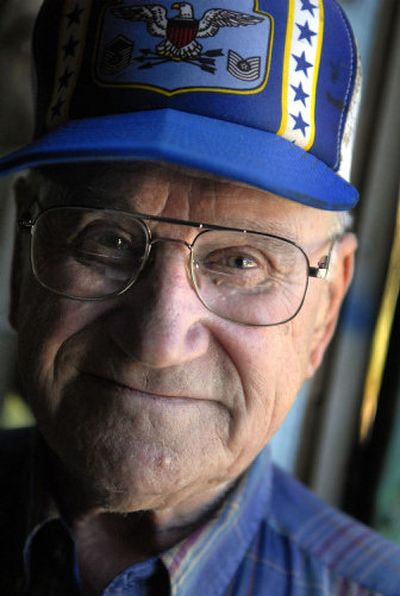Missile launch controller a relic of the Cold War

When a subject line saying “the thing” popped up among other spam in my e-mail inbox, my first response was to hit “Delete,” thinking it was one of those pill-pushing e-mails promising to make “things” grow – but I opened it anyhow.
And that’s how I got to correspond with Richard C. Mellor.
He told me matter-of-factly that he has a missile launcher sitting in his garage.
Now that’s the kind of statement that’ll make a journalist jump to a few conclusions, but curiosity got the best of me.
In the next e-mail Mellor clarified that he didn’t own an actual missile – so, knowing that I couldn’t get blown up, I agreed to visit “the thing” last week.
What Mellor has in his garage is a Facilities Remote Control Panel.
It’s shaped like a nice-sized roll-top desk, but its purpose was much more sinister: During the Cuban missile crisis it controlled the launch of nuclear warheads, and Mellor was one of the people staffing it in the early ‘60s.
At the time, there was a “thing” installed at each of the nine, identical top-secret nuclear missile sites located around here in, among other locations, Deer Park, Davenport and Newman Lake. In case you wanted to launch an Atlas-E missile with a 4-megaton nuclear warhead, the button is right there on the dash of “the thing” – among dozens of other buttons and gauges.
One person couldn’t fire a missile on his own, Mellor explains to me. It took two people to simultaneously push two buttons in separate locations to actually launch the missile, or as Mellor affectionately calls it, “the bird.”
They went through practice countdowns all the time, Mellor says as we stand there in the summer-hot garage with his turquoise vintage VW Bug parked behind us.
Such contrast: A “thing” that once could launch the nuking of hundreds of thousands of people now sits here, hopelessly outdated, its computerless electronic brain exposed in the back, looking like something that came out of a pretend spaceship in an amusement park. This is one heck of a change of scenario compared to when Mellor and “the thing” first got acquainted in the sterile interiors of the missile silos.
“I worked at all nine sites out here,” says Mellor, as we visit in his little camper next door, hummingbirds fighting over the feeder outside.
In his 20-year military career, Mellor was a communications and microwave site specialist; he transferred to Fairchild in ‘60.
“I showed up thinking communication was what I would be doing, but then they sent me to missile school,” he says.
He returned to train people here at the missile sites in ‘62.
“Nobody knew what we were doing,” he says. “We couldn’t tell our families, or friends, anybody. The average person here had no idea that there were missile sites around town.”
Then he cracks open a binder with color photos taken at the sites back in ‘61 and ‘62.
My mouth falls open.
“You weren’t supposed to have those pictures,” I blurt out. “They would have shot you. Are you nuts?”
Mellor laughs at my reaction.
“I know nothing,” he deadpans, eyes twinkling.
I flip through overhead pictures of the sites, close-ups of warheads, a crew celebrating an impromptu Christmas dinner, cozily settled among rooms full of “logic units” – the computers of the early ‘60s.
The pictures also show “the thing” in its original habitat: an underground control room.
“So how did you two reconnect?” I ask, still baffled.
Mellor returned to Spokane in ‘72 – retired after serving in Vietnam – and went on with life together with his wife, Eleonore, and their sons.
The missile silo sites were decommissioned in ‘65, but Mellor connected with some of his old buddies from the underground crews.
Mellor found “the thing” in the care of Mark Kraemer, of Harrington.
“He still owns it,” Mellor says, absentmindedly patting its military green metal cover.
Mellor fixed the wiring – “the thing” can go through a complete pretend launch, lights flashing, countdown ticking, just like it was still hooked up – and it was part of the exhibit at the Fairchild Museum. When the museum closed and some of the exhibits were shipped out of state to other museums, “the thing” found a home in Mellor’s garage.
“They were some kind of upset with us about that,” he says, reminiscing. “But we were smarter than the average bear: All the stuff from the sites was on loan to the museum. This thing holds too much history of this area – we did not want to let it go.”
I suggest Mellor take it down to the “Antiques Roadshow,” and he gets a good laugh out of that. Then I ask him what he wants to do with it.
“I want for it to be at permanent display at the museum we are trying to build,” Mellor says, referring to the Armed Forces & Aerospace Museum, for which fundraising is under way.
The proposed museum has a price of $5.8 million, of which a little more than $1.3 million has been raised, according to its Web site.
Mellor turned 74 last month. Many of the people he worked with back then have passed away – soon no one will know what “the thing” is. We don’t really talk about that. Instead we talk about the current war, the nature of hummingbird squabbles and where Osama bin Laden really is hiding.
As I get into my car I jokingly tell Mellor to stay out of trouble for now.
“Why?” he asks, “there never was any fun in that.”